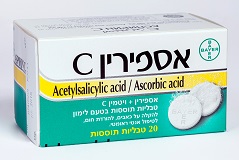Quest for the right Drug

אספירין C ASPIRIN C (ACETYLSALICYLIC ACID, ASCORBIC ACID)
תרופה במרשם
תרופה בסל
נרקוטיקה
ציטוטוקסיקה
צורת מתן:
פומי : PER OS
צורת מינון:
טבליה תוססת : TABLETS EFFERVESCENT
עלון לרופא
מינוניםPosology התוויות
Indications תופעות לוואי
Adverse reactions התוויות נגד
Contraindications אינטראקציות
Interactions מינון יתר
Overdose הריון/הנקה
Pregnancy & Lactation אוכלוסיות מיוחדות
Special populations תכונות פרמקולוגיות
Pharmacological properties מידע רוקחי
Pharmaceutical particulars אזהרת שימוש
Special Warning עלון לרופא
Physicians Leaflet
Pharmacological properties : תכונות פרמקולוגיות
Pharmacodynamic Properties
5.1 Pharmacodynamic properties Pharmacotherapeutic group: Nervous system, other analgesics and antipyretics, salicylic acid and derivatives ATC class: N02BA01 Acetylsalicylic acid Acetylsalicylic acid belongs to the class of acid-forming nonsteroidal anti-inflammatory drugs with analgesic, antipyretic and anti-inflammatory properties. Its mechanism of action is based on the irreversible inhibition of cyclooxygenase enzymes involved in prostaglandin synthesis. Acetylsalicylic acid is used at oral doses of between 0.3 and 1.0 g to treat mild to moderate pain and fever, e.g. with colds or flu, to lower temperatures and to treat joint and muscle pain. It is also used to treat acute and chronic inflammatory diseases such as rheumatoid arthritis, osteoarthritis and ankylosing spondylitis. Acetylsalicylic acid also inhibits platelet aggregation by blocking the synthesis of thromboxane A2 in platelets. To this end, doses of 75 to 300 mg daily are used for various cardiovascular indications. Ascorbic acid The water-soluble vitamin ascorbic acid is part of a protective system of the body against oxygen radicals and other oxidants of endogenous and exogenous origin which also play an important role in the inflammatory process and in leukocyte function. Both in vitro and ex vivo experiments indicate that ascorbic acid has a positive effect on the leukocytic immune response in humans. Ascorbic acid is essential for the synthesis of intracellular substances (muco- polysaccharides) which, together with the collagen fibres, are responsible for sealing the capillary walls. Clinical studies have yielded evidence that using acetylsalicylic acid and ascorbic acid in combination provides protection against acetylsalicylic acid-induced gastric lesions and oxidative stress.
Pharmacokinetic Properties
5.2 Pharmacokinetic properties Acetylsalicylic acid is absorbed rapidly and completely from the gastrointestinal tract after oral administration. Acetylsalicylic acid is converted into its main metabolite salicylic acid during and after absorption. Peak plasma levels of acetylsalicylic acid and salicylic acid are achieved after 15-30 min. and 0.72-2 h respectively. The given durations depend on the pharmaceutical form. The addition of ascorbic acid leads to little or no variability in the PK parameters of acetylsalicylic acid. Both acetylsalicylic acid and salicylic acid are bound largely to plasma proteins and rapidly distributed to all parts of the body. Salicylic acid passes into breast milk and crosses the placental barrier. Salicylic acid is eliminated predominantly by metabolism in the liver; the metabolites are salicyluric acid, salicyl phenolic glucuronide, salicylic acyl glucuronide, gentisic acid and gentisuric acid. The elimination kinetics of salicylic acid are dose-dependent, as metabolism is limited by the liver enzymes' capacity. The elimination half-life therefore varies and lies between 2 and 3 h at low doses and up to about 15 h at high doses. Salicylic acid and its metabolites are excreted primarily via the renal route. Absorption of ascorbic acid (concentration-dependent in the proximal section of the small intestine) is limited. As the single dose increases, bioavailability decreases (60-75% after 1 g, 16% after 12 g). The unabsorbed fraction is broken down by the flora in the large bowel, mainly into CO2 and organic acids. In healthy adults, the maximum metabolic turnover of 40-50 mg/day is reached at plasma concentrations of 0.8-1.0 mg/dL. Total turnover is in the range of 1 mg/day. At extremely high oral doses, plasma concentrations of up to 4.2 mg/dL are achievable in the short-term after three hours. Under these conditions, ascorbic acid is excreted predominantly (>80%) unchanged in the urine (half-life 2.9 hours). The pool in the body following regular administration of approximately 180 mg/day is at least 1.5 g. Significant accumulation occurs in the pituitary gland, adrenal glands, eye lenses and white blood cells.

שימוש לפי פנקס קופ''ח כללית 1994
לא צוין
תאריך הכללה מקורי בסל
לא צוין
הגבלות
לא צוין
מידע נוסף
עלון מידע לצרכן
29.09.21 - עלון לצרכן אנגלית 25.07.22 - עלון לצרכן אנגלית 12.05.22 - עלון לצרכן עברית 29.09.21 - עלון לצרכן ערבית 25.07.22 - עלון לצרכן ערבית 28.09.24 - עלון לצרכן עברית 29.11.11 - החמרה לעלון 15.05.12 - החמרה לעלון 07.07.20 - החמרה לעלון 13.09.20 - החמרה לעלון 25.06.21 - החמרה לעלון 12.05.22 - החמרה לעלון 25.07.22 - החמרה לעלוןלתרופה במאגר משרד הבריאות
אספירין C